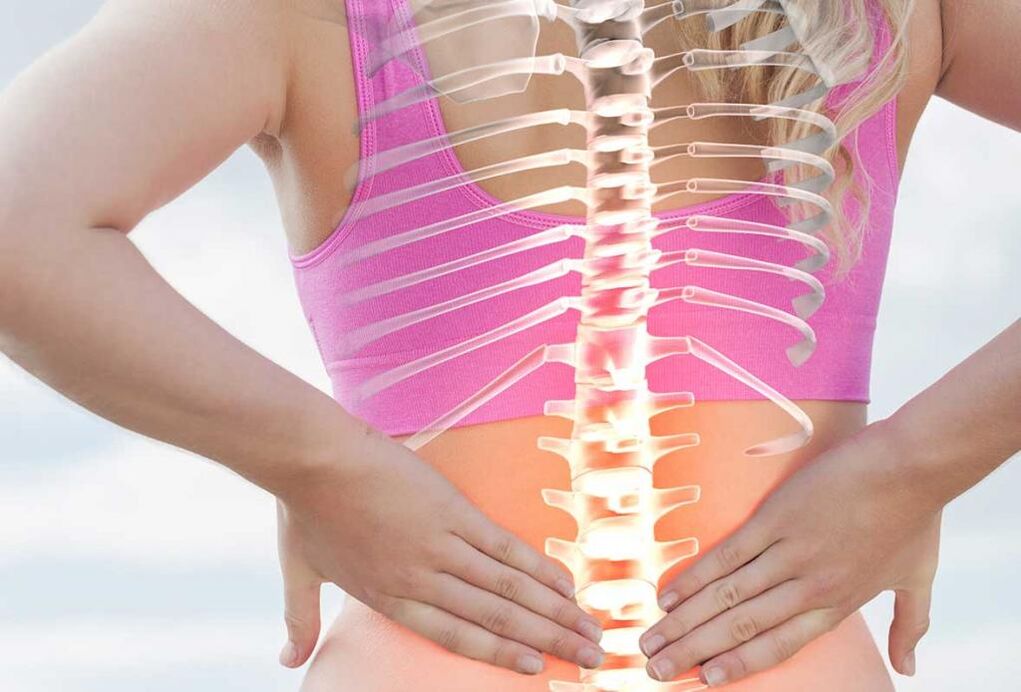The lumbar spine unites the thoracic region with the sacrum, is characterized by great mobility and has 5 vertebrae. Regardless of a person's lifestyle, this part of the ridge is subjected to quite heavy loads every day. That is why lumbar osteochondrosis is considered a very common pathology, in which the intervertebral discs between the vertebrae are deformed. Without proper treatment, dangerous complications can develop.

Common symptoms of osteochondrosis of the lumbar spine
The first and main sign of the development of the disease is constant acute pain in the lumbar region. The pain can come on suddenly. The back loses flexibility, it is difficult for a person to perform turns or tilts. In certain situations, pain can spread to the lower limbs or buttocks.
The following main signs of the disease are distinguished:
- pain increases with the slightest physical activity with coughing or sneezing;
- limited mobility of the lumbar zone after staying in one position for a long time;
- constant tension of the back muscles;
- back pain;
- tingling and tingling, shivering in the lower extremities;
- sensory disturbances in the thighs, buttocks and sometimes the foot;
- disturbed sweating;
- spasm of the arteries of the feet, the pulse may disappear;
- Loss of sensitivity is possible in painful areas, peeling, as well as dryness of the skin.
Very often, a patient suffering from lumbar osteochondrosis suffers from irritability and general fatigue. It is difficult for a person to find a comfortable position for relaxing in bed, and as a result, the patient's sleep is disturbed. In addition, with this pathology there can be a violation of the functions of the organs of the genitourinary system.
Medical treatment of lumbar osteochondrosis
Treatment of the disease with the help of drugs is prescribed:
- to relieve pain;
- to relax tense muscles;
- to relieve inflammation in the nerve endings;
- to improve metabolism in tissues;
- to restore damaged cartilage tissue;
- to normalize blood flow.
All of the above tasks are solved by an individual treatment regimen correctly chosen by the doctor.
To treat the disease, the following drugs are prescribed in the form of tablets:
- To relieve pain, analgesics are used that act quickly - analgin. It should be remembered that in the acute course of osteochondrosis, these drugs are characterized by a short-term effect;
- to relieve pain and reduce inflammation use nonsteroidal anti-inflammatory drugs;
- Chondroprotectors are used to protect cartilage tissue from further destruction;
- To improve the patient's condition, it is also recommended to take vitamins and immunomodulators in the form of tablets.
Drug therapy includes the use of creams, ointments and gels. All drugs for topical use can be divided into the following groups:
- Medicines containing analgesics or anti-inflammatory non-steroidal drugs. This group has an analgesic effect;
- combined medicines. These drugs contribute to tissue repair, have anti-inflammatory as well as absorbable effects. They are characterized by analgesic and thrombolytic effects;
- Drugs that have analgesic, as well as local irritant effects. They dilate blood vessels, increase blood flow to the affected area, normalize metabolic processes;
- chondroprotectors in the form of topical agents;
- Homeopathic remedies are characterized by anti-inflammatory, anti-edematous effects. They have an analgesic and strengthening effect.
In addition, massage balms, which have a dissolving and anti-inflammatory effect, have a good effect. These drugs are characterized by an analgesic effect.
We should not forget about such a method of drug therapy in the treatment of lumbar osteochondrosis as injections. Injections will help get the drug into the body in a short time. Blockades of the spine are considered effective - the introduction of an anesthetic in places with affected nerve roots. Rapid pain relief is achieved with this method.
Blocks are prescribed for urgent pain relief, to reduce spasms, strains and tension in the muscles, positively affecting the inflammatory process.
In addition to blocks, with lumbar osteochondrosis, ordinary injections are also prescribed for intramuscular or intravenous administration.
To relieve psychoneurological pathologies, sedatives, anticonvulsants and antidepressants can be used.
With manifestations of radiculopathy, the doctor prescribes diuretics, and with paralysis, taking anticholinesterase drugs.
The pharmaceutical industry produces a large number of drugs to combat the disease, taking them can only be prescribed by a doctor.
Treatment with physiotherapy for lumbar osteochondrosis
For the effectiveness of therapy for lumbar osteochondrosis, drug treatment should be supplemented with physiotherapy:
- Electrotherapy is considered one of the most common ways to relieve muscle soreness. The method uses a weak current. The course of treatment - 6 procedures;
- Laser therapy allows you to remove inflammation and improve microcirculation. The affected area is affected by electromagnetic waves and quantum particles. The infrared ray penetrates deep into the tissue, stimulates metabolic processes and activates the regeneration of cartilage tissue.
- detensor therapy. The essence of the method is the extension of the spine under its own weight. A special mattress is used. The method allows you to normalize muscle tone;
- Shockwave therapy can relieve pain and reduce swelling. The essence of the method is the action of constant or variable magnetic fields of different frequencies;
- Ultrasound therapy helps reduce inflammation and pain. Ultrasound waves, which act selectively on the affected areas, activate metabolic processes.
In addition, UV irradiation and vibration therapy can be used on vibrating massagers.
Lumbar osteochondrosis is considered a fairly common disease. With untimely treatment, the pathology can cause dangerous complications. Complex therapy of osteochondrosis usually eliminates the unpleasant manifestations of the disease and returns the patient to everyday life.




















